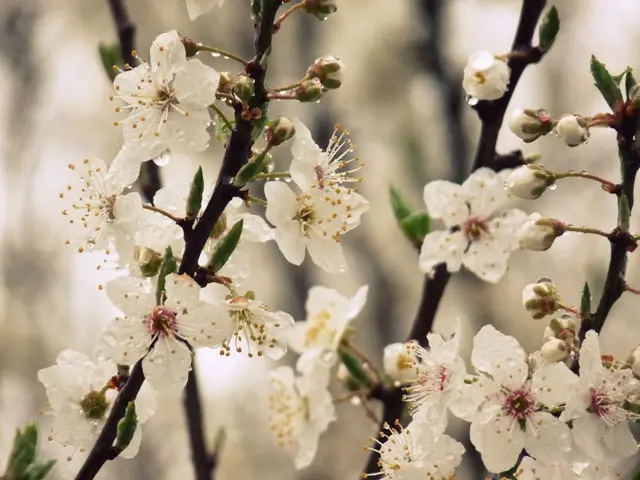"Ikea introduced vibrant patterns into homes of the general public: an exploration of their strategy"
IKEA, the global icon of affordable and functional design, has a rich history in revolutionising textiles and visual design, particularly in the 1960s and beyond. This transformation was driven by founder Ingvar Kamprad's vision to hire young, mostly female designers from art schools and give them unprecedented creative freedom[1][2].
Key aspects of this revolution include the introduction of bold, geometric, and psychedelic patterns that challenged traditional elite design norms[1][2][3]. Designers like Inez Svensson pioneered geometric prints in the 1970s, pushing technological boundaries in textile printing[1][3]. This approach turned textiles into a gateway for democratising home aesthetics, moving beyond mere function to make homes vibrant and expressive spaces[1][3].
The youthful, provocative design ethos has persisted as a core aspect of IKEA’s identity, influencing their visual language up to the present day[3]. IKEA’s revolution was not just in furniture affordability but also in visual design innovation, enabling mass access to modern, artistic textile patterns that reshaped home decor globally from the 1960s onward[1][2][3].
Sven Fristedt joined IKEA in 1967 and introduced a range of organic, psychedelic, and Nordic folk-inspired motifs. Designers like Tom Hedqvist, another IKEA designer and co-founder of 10-Gruppen, played a role in the creation of some IKEA patterns[1][2]. Anna-Lena Emdén introduced humor and narrative to IKEA's children's prints in the 1970s[1][2].
IKEA's approach to pattern design is rooted in its philosophy of accessibility, championed by Ingvar Kamprad. Fabrics sold by the metre and a mix-and-match ethos, such as the 2024 'Tyg' line, empower people to be co-creators of their homes[1][2]. Ida Pettersson Preutz's design brief for IKEA was to create a pattern based on food, leading to the creation of the 'Anniken' print[1][2].
IKEA's textiles are almost as iconic as its flat-pack furniture. Anna Sandberg Falk, an exhibition curator at the IKEA Museum in Sweden, observes that IKEA's early catalogues were mainly beige or grey[1][2]. However, in the early 1960s, IKEA started to use bold colors in its textile designs[1][2].
10-Gruppen's work for IKEA introduced bold, youthful patterns and was revived in 2017, underscoring its lasting relevance[1][2]. Inez Svensson, a key figure in the development of IKEA's textile designs in the 1960s and 70s, co-founded the design collective 10-Gruppen, which challenged the dominance of dainty florals in textiles[1][2].
The impact of IKEA's textile revolution is still evident today. Anna Sörensson's 'Stockholm' pattern, introduced in 2006, remains popular today[1][2]. IKEA's 80th anniversary Nytillverkad collection, introduced in 2023, included designs based on earlier patterns like 'Alfi' and 'Strix'[1][2].
For those interested in exploring this revolution further, the exhibition 'Ikea: Magical Patterns' is currently running at Edinburgh's Dovecot Gallery until 17 January 2026[1][2]. This exhibition offers a unique opportunity to delve into the history of IKEA's textile designs and their influence on global home decor.
References:
[1] "IKEA: Magical Patterns." Dovecot Gallery. https://www.dovecotstudios.com/exhibitions/ikea-magical-patterns
[2] "IKEA's 80th Anniversary Collection Brings Back Iconic Patterns." Dezeen. https://www.dezeen.com/2023/01/09/ikea-80th-anniversary-collection-brings-back-iconic-patterns/
[3] "How IKEA Revolutionised Home Decor." BBC. https://www.bbc.com/culture/article/20210115-how-ikea-revolutionised-home-decor
- IKEA, a pioneer in affordable and innovative design, revolutionized textiles and visual design, particularly in the 1960s, by hiring young, mostly female designers from art schools and offering them creative freedom.
- Designers like Inez Svensson were instrumental in introducing geometric prints in the 1970s, pushing technological boundaries in textile printing.
- This approach transformed textiles into a gateway for democratizing home aesthetics, making homes vibrant and expressive spaces beyond mere function.
- Sven Fristedt, who joined IKEA in 1967, introduced organic, psychedelic, and Nordic folk-inspired motifs.
- Today, IKEA's revolution in visual design innovation is not just about furniture affordability but also about democratizing access to modern, artistic textile patterns that reshaped global home decor.
- Anna-Lena Emdén introduced humor and narrative to IKEA's children's prints in the 1970s.
- IKEA's approach to pattern design is rooted in its philosophy of accessibility, selling fabrics by the meter and promoting a mix-and-match ethos.
- Ida Pettersson Preutz's design brief for IKEA was to create a pattern based on food, leading to the creation of the 'Anniken' print.
- IKEA's textiles are almost as iconic as its flat-pack furniture, with bold colors becoming a common feature in its textile designs from the early 1960s.
- The revived 10-Gruppen's work for IKEA in the 1960s and 70s introduced bold, youthful patterns that remain relevant today.
- Anna Sörensson's 'Stockholm' pattern, introduced in 2006, remains popular today, demonstrating the lasting impact of IKEA's textile revolution.
- In 2023, IKEA introduced the 80th anniversary Nytillverkad collection, which included designs based on earlier patterns like 'Alfi' and 'Strix'.
- For those interested in exploring this revolution further, the exhibition 'Ikea: Magical Patterns' is currently running at Edinburgh's Dovecot Gallery until 17 January 2026.
- This exhibition offers a unique opportunity to delve into the history of IKEA's textile designs and their influence on global home decor, learning about the skills training, personal growth, and cultural travel that are part of the lifelong learning process.




